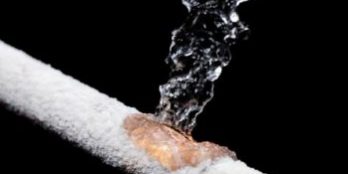Icy Air Conditioner Pipe - Identifying and Resolving the Issue Promptly
Icy Air Conditioner Pipe - Identifying and Resolving the Issue Promptly
Blog Article
Presented here in the next paragraph you will find lots of first-rate resources regarding Air Conditioner Frozen? How To Fix your Frozen AC Line.

Introduction
Discovering that your air conditioning pipeline is frozen can be worrying, especially during hot summer months when you rely upon your air conditioner the most. Understanding what to do in such a scenario is critical to stop more damage to your air conditioning system and ensure your convenience indoors.
Understanding the Causes
Several variables can add to the freezing of an AC pipe. Recognizing these causes can aid you resolve the concern effectively.
Absence of Airflow
One typical cause of a frozen air conditioning pipeline is inadequate airflow. When the air movement over the evaporator coil is restricted, it can create the coil to go down below freezing temperature level, leading to ice development on the pipe.
Low Refrigerant Levels
Not enough cooling agent levels in your air conditioning system can additionally lead to a frozen pipeline. Low cooling agent degrees can trigger the stress in the system to drop, leading to the cold of wetness on the evaporator coil.
Cold Weather Conditions
In cooler environments, freezing temperatures outside can contribute to the cold of air conditioning pipes. If your air conditioning device is not effectively insulated or if there are leakages in the ductwork, cool air can penetrate the system, triggering the pipe to freeze.
Dirty Air Filters
Dirty or clogged air filters can restrict airflow in your AC system, bring about numerous issues, including an icy pipeline. It's necessary to change or cleanse your air filters frequently to ensure proper airflow and stop ice buildup.
Indicators of a Frozen AC Pipe
Identifying the indicators of an icy AC pipeline is essential for prompt activity.
Lowered Airflow
If you observe a considerable decrease in air movement from your vents, it can suggest a frozen pipeline.
Ice Buildup on the Pipe
Visible ice build-up on the cooling agent line or the evaporator coil is a clear indicator of a frozen air conditioner pipeline.
Unusual Sounds from the Unit
Uncommon noises, such as hissing or bubbling, coming from your air conditioner device can indicate that there's ice present on the pipeline.
Immediate Actions to Take
When confronted with a frozen air conditioning pipeline, it's necessary to act swiftly to avoid additional damages to your air conditioning system.
Turning off the AC
The first step is to turn off your ac unit to stop the system from running and aggravating the concern.
Checking for Blockages
Examine the area around the indoor unit for any kind of obstructions that may be obstructing air movement, such as furnishings or drapes.
Thawing the Pipe
You can use mild methods like placing towels soaked in warm water around the icy pipeline to assist thaw it slowly.
Safety nets
Taking preventive measures can help avoid future events of an icy a/c pipe.
When DIY Methods Fail
If your efforts to thaw the pipe or address various other issues are not successful, it's time to contact a professional.
Value of Hiring a Professional HVAC Technician
A certified HVAC specialist has the expertise and tools essential to diagnose and fix concerns with your a/c system safely and properly.
Routine Maintenance Checks
Set up regular upkeep checks with a specialist HVAC technician to ensure that your air conditioner system is running efficiently.
Altering Air Filters
Consistently replace or cleanse your air filters to avoid air flow restrictions and preserve ideal efficiency.
Shielding Exposed Pipes
If your AC pipes are subjected to cool temperature levels, think about shielding them to prevent freezing during cold weather.
Seeking Professional Help
If DIY methods fail to fix the problem or if you're unclear concerning just how to continue, it's best to seek support from a certified HVAC professional.
Verdict
Handling a frozen a/c pipeline can be a frustrating experience, however recognizing just how to react can help minimize damage and bring back comfort to your home. By recognizing the reasons, identifying the indicators, and taking prompt action, you can efficiently deal with the problem and stop future incidents.
Frozen AC Line: Why It Happens & What To Do About It
A frozen AC line can be a rather peculiar sight in a place like Phoenix, Arizona where nothing ever freezes. In this post, we’ll discuss what makes an air conditioner line frozen – and what you can do about it.
Dirty Air Filters
Did you know that you should be cleaning or replacing your air filters on a monthly basis? Failing to do this can result in airflow issues that, in turn, cause your evaporator coils and lines to freeze over. You’ll notice a buildup of ice on both components, although the buildup on your pipes will, of course, be more evident unless you open your air condition up to reveal the coils.
What To Do About It
Give your air filter a good cleaning if it’s reusable. If not, replace the filter outright. Next, switch your air conditioner’s fan setting on and leave it there for 2-3 hours. This will draw warm air in, helping to thaw your evaporator coil. You can also check out this article for some tips on cleaning the coils themselves if you’d like to speed the process up. Before you switch the unit back to its normal state, make sure the supply vents are completely unobstructed and free of dust or other debris.
If you keep having this issue even after replacing your filters regularly, contact a local HVAC repair company and have them inspect your evaporator coil, ductwork, and any other components that may be at fault. If you live in the Phoenix, Arizona area, give American Home Water and Air a call.
Low Refrigerant Levels/Leakage
What To Do About It
Contrary to what air conditioner “recharge” companies often tell their clients about refrigerant, it should never need to be simply refilled. You see, refrigerant runs in what experts refer to as a “closed loop.” Refrigerant really shouldn’t be leaving that loop. If it is, you’ve got a leak.
Paying someone to come and pump more refrigerant into your system (aka “recharge” it) isn’t the solution. Doing that will simply kick the can down the road. Besides, refrigerant leaks can be harmful to the environment and people in your home.
Rather, you need to take care of the leak with the help of a technician. Check out this article for some more information about dealing with air conditioners that are leaking refrigerant. Before you contact a technician, switch your thermostat to the off position. Then, switch the fan setting on and let it run for 2-3 hours so the unit can thaw.
Improper Temperature Setting
Improper temperature settings can also cause a drop in your air conditioner’s pressure. What many people don’t realize is that air conditioners are actually designed to run when temperatures have fallen above roughly 60 degrees Fahrenheit. If you run the unit when it’s cold outside, you’ll run into many issues, including frozen components.

We had been made aware of that write-up on Air Conditioner Frozen? How To Fix your Frozen AC Line from a good friend on another web page. For those who enjoyed our blog post kindly make sure you remember to pass it around. I enjoy reading our article about Air Conditioner Frozen? How To Fix your Frozen AC Line.
Visit Homepage Report this page